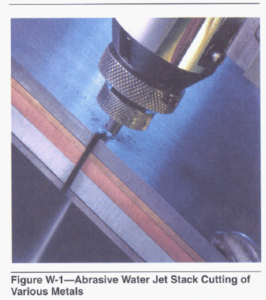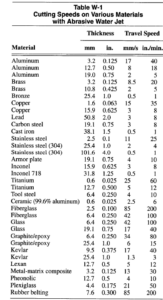Water jet cutting, also called hydrodynamic machining, severs metals and other materials using a high-velocity water jet. The jet is formed by forcing water through a 0.1 to 0.6 mm (0.004 to 0.024 in.) diameter orifice in a man-made sapphire under high pressure (207 to 414 MPa[30 000to 60 000 psi]). Jet velocities range from 520 to 914 m/s (1700 to 3000 ft/s). At these speeds and pressures the water erodes many materials rapidly, acting like a saw blade. The water stream, with a flow rate of 0.4 to 19 Umin (0.1 to 5 gal/min), is usually manipulated by a robot or gantry system, but small workpieces may be guided manually past a stationary water jet.
Metals and other hard materials are cut by adding an abrasive in powder form to the water stream. With this method, called hydroabrasive machining or abrasive jet machining, the abrasive particles (often gamet) are accelerated by the water and accomplish most of the cutting. Higher flow rates of water are required to accelerate the abrasive particles.
Materials are cut cleanly, without ragged edges (unless the traverse speed is too high), without heat, and generally faster than on a band saw. A narrow, 0.8 to 2.5 mm (0.030 to 0.100 in.), smooth kerf is produced. There is no problem of thermal delamination, or deformation, when water jet cutting is properly applied.
The wide application range and lack of beat are the major advantages of water jet cutting. The versatility of the process is demonstrated by the simultaneous cuts through carbon steel, brass, copper, aluminum, and stainless steel shown in Figure W-1.

Water jet and abrasive water jet systems compete with such processes as band saws, the reciprocating knife, flame cutting, plasma, and laser cutting. They can handle materials that are damaged by heat from thermal processes, or materials that gum up mechanical cutting tools. In some cases, they can cost effectively replace three operations: rough-cutting, milling, and deburring of contoured shapesl. The wide range of materials which may be cut appears in Table W-1.


